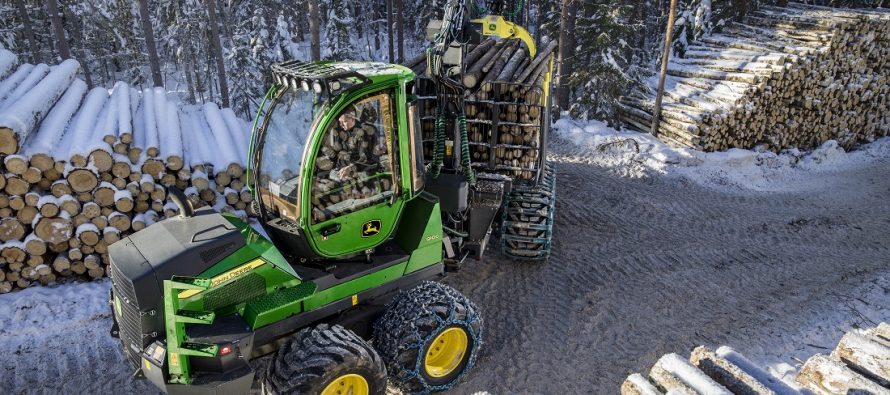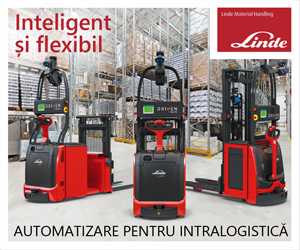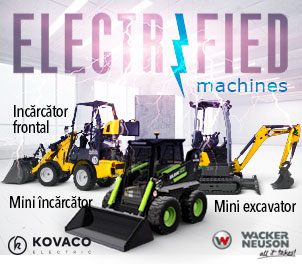John Deere to showcase at Finnmetko the G-Series small forwarders and the market’s smartest tool for logging planning & monitoring

Related Articles
Revolutionizing the planning of logging, TimberMatic Maps gives operators a real-time production view of the logging site. The data collected by the harvester’s sensors and the precise GPS-based location of the felled timber is automatically transmitted from the harvester to the TimberMatic application for use by the forwarder operator.
The data between the machines are updated in real-time through a cloud service, and all the operators working at the same job site can see the logging situation in real-time. The map shows all the types of timber, right down to the individual logs.
Work planning and selecting an efficient driving route becomes unprecedentedly simple when the precise location and volume of the different tree species are shown on the map with the network of logging routes. Forwarder operators can choose, for example, the location of the desired tree species from a specific area of the logging site or along a specific logging route, and the map shows the precise volume of the timber, thereby making for methodical and efficient work. Operators can easily mark the map to indicate the timber they have transported to the storage area. This way, information about the precise volume of the timber taken to the storage area is available. Precise information about the logging progress is visible to the operators as well as to the contractor in real-time.
 As the logging progresses, the machine’s production and the logging routes appear in real-time on the map. Additionally, the operators can add markings to the map to point out locations to other operators. This makes it easy to factor in other things, like an area with soft ground, when planning the route. The real-time map also makes it possible for the operator in the next shift to see the actual status of the logging site – right down to individual logs.
As the logging progresses, the machine’s production and the logging routes appear in real-time on the map. Additionally, the operators can add markings to the map to point out locations to other operators. This makes it easy to factor in other things, like an area with soft ground, when planning the route. The real-time map also makes it possible for the operator in the next shift to see the actual status of the logging site – right down to individual logs.
The system has operator- and contractor-dedicated displays that reflect the real-time situation of the job site. TimberMatic Maps is used in the cabin of the forest machines and TimberManager is used by the contractor to see the felling progress at the logging site. The system visually displays the logging progress as cubic meters and as a percentage for the felled timber and for the timber that has been transported to the road-side storage area. The precise volume of timber at the storage site facilitates the contractor’s work in determining the needed trailer transports and the onward transportation of the timber. Accurate data facilitates the operations of the entire supply chain. There is no longer a need to estimate the volume, and not a single log will be left in the forest because all the different tree species will be accurately displayed on the map – right down to the single log, even if it is dark or they are covered by snow.
TimberMatic Maps and TimberManager are standard features in all new John Deere G-Series harvesters and forwarders as of autumn 2018. The system can also be retrofitted to older machines meeting the equipment requirement.
John Deere 910G and 1010G offer solutions for all conditions
The efficient performance of the new forwarder models in all conditions is ensured by the wide range of axle and tire options. The John Deere 910G is available in a 6-wheeled version with 34-inch tires in the front and 24.5-inch tires in the rear, or an 8-wheeled version with either 22.5- or 24.5-inch tires. The 6-wheeled John Deere 1010G with 34-inch tires in the front comes with two rear tire options: 24.5 and 26.5 inches. The 8-wheeled 1010G can be equipped with either 24.5- or 26.5-inch tires.
John Deere 910G has a load rating of 9 tons (22.5-inch tires) or 10 tons (24.5-inch tires), and its excellent agility makes it ideal for first thinnings. The 910G is available with either six or eight wheels and with a narrow or wide load space with cross-section areas of 3.5 m² and 4.0 m². Choose either a fixed or a leveling and rotating cabin. Boom options include CF1 and CF5 with three different reaches. The engine has significantly more power (118 kW) and torque (650 Nm) than the previous corresponding size-class model, the 810E.
 John Deere 1010G has a load rating of 11 tons. The engine has significantly more power (131 kW) and torque (730 Nm) than the previous 1010E model. The 1010G is available with six or eight wheels and with a narrow or wide load space (3.5 m² or 4.0 m²). The model can be equipped with either a fixed or a leveling and rotating cabin, and the CF5 boom has three different reach alternatives.
John Deere 1010G has a load rating of 11 tons. The engine has significantly more power (131 kW) and torque (730 Nm) than the previous 1010E model. The 1010G is available with six or eight wheels and with a narrow or wide load space (3.5 m² or 4.0 m²). The model can be equipped with either a fixed or a leveling and rotating cabin, and the CF5 boom has three different reach alternatives.
New design brings comfort to the small-class G-series forwarders. The engine space and the hood have been designed in collaboration with BMW DesignWorks. The engine hood has been lowered and the operator’s visibility from the cabin to the work area has improved.
Both models are available also with a short wheelbase. The shorter wheelbase has been achieved by moving the rear axle forward by 40 cm, thereby allowing the load space to remain unchanged. The machine’s stability remains good and its agility improves, which is beneficial particularly in thinnings.
John Deere 1010G is available with the long bogie version. The distance between the front and rear wheel hubs in the rear bogie increases to 1890 mm, i.e. 390 mm longer than in the standard model. The power train and turning radius are the same as with the standard HD portal bogie-equipped machine. The ground pressure of the rear chassis equipped with tracks is 14% smaller compared to an ordinary bogie axel. The low ground pressure of the machine’s front and rear chassis make the machine an excellent choice for logging on soft terrain. The tracks are shallower and the depression is smaller. The long bogie functions well also on normal terrain and brings stability when navigating over obstacles in rocky terrain.
Stage 5 – John Deere engines
The 4.5-liter John Deere PowerTech Plus 4045, the 6.8-liter John Deere PowerTech Plus 6068 and the 9.0-liter John Deere PowerTech Plus 6090 engines meet Stage 5 emissions regulations. The engine’s RPM range is wide and it offers a lot of torque at low RPMs. The RPM remain steady also during big and rapidly changing loads. The better coupling of the powerful diesel engine with the power train results in a clear improvement in performance.
Adaptive driveline control is a unique standard feature in John Deere’s G-Series forest machines. The software-based control system improves the drivability and productivity of the G-Series machines. The operator selects the desired setting (Eco, Normal, Power) for the operating conditions, and the system automatically adjusts the engine’s RPMs to correspond with the engine load and keeps the RPMs steady also during high loads. During high-load situations, the new driveline control ensures that the diesel engine runs smoothly and uses the available maximum tractive force efficiently. The response of the drive pedal and the frame steering has been improved with smart electronic filtering.
 Intelligent Boom Control available for the CF5 boom of the 910G and 1010G forwarders
Intelligent Boom Control available for the CF5 boom of the 910G and 1010G forwarders
The boom control precision of the G-Series machines is unprecedented. New control modules, simple CAN busses, and a clear electrical system give the booms more power, speed and processing precision. The unique Intelligent Boom Control (IBC) was introduced to John Deere’s forwarders in 2013, and is now available also for the CF5 boom of the 910G and 1010G forwarders. Over 80% of John Deere forwarders delivered to the Nordic countries are equipped with IBC, and virtually all 1270G and 1170G harvesters have this feature.
IBC is an intelligent boom control system with sensors that detect the positioning of the grapple and algorithms that adjust the boom’s trajectory in one continuous motion. The operator guides the grapple to the desired position and the system optimizes the trajectories of the different sections of the boom. In the 2.0 version of IBC, the precision of the grapple control has been improved, especially in long reaches. Thanks to the electronic end damping, the boom operates softly. With the blow-like loads in the end positions eliminated, the operator’s work is smoother and the boom’s durability is improved. IBC makes load-handling more efficient and increases productivity by as much as one load per day. Our machines are also known for the unique rotating and leveling cabin that improves the operator’s working conditions. It offers significant improvement both in the machine’s productivity and in operator comfort by reducing vibration by as much as 30-50% during operation.
The entire G-Series harvester and forwarder model lineup is on display at the FinnMetko exhibition.







